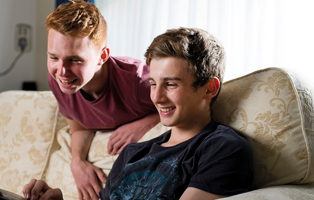All accredited independent boarding schools are inspected under the ISI Inspection Framework which came into force in January 2017. Every three years, the inspection will be a Regulatory Compliance Inspection (RCI) which, in terms of boarding, will inspect the boarding provision against Boarding Schools: National Minimum Standards (NMS). Full details of the Standards (the latest April 2015 version) can be found at click here
Assuming the school meets the minimum standards and no immediate action is required, or unless the Department for Education (DfE) has commissioned an additional inspection, the next ISI inspection experience for a boarding school in the cycle will be a Focused Compliance Inspection (FCI) and an Inspection of Education Quality (EQI). The FCI will inspect the boarding provision against Boarding Schools: National Minimum Standards. Immediately following the FCI, the EQI will evaluate the quality of the outcomes for pupils. This will evaluate pupils’ achievement and pupils’ personal development. Educational quality findings will be reported against a four-point scale. For boarding provision, the inspection and the report will include the contribution of boarding to boarders’ achievement and their personal development. Full details of this new inspection framework can be found on the ISI website. Readers should note that, depending on the dates of previous inspections, a FCI-EQI inspection might come before a RCI inspection. Schools should prepare for both types.
Over the last 20 years, good practice in boarding schools has developed significantly and schools have responded positively to national legislation. The effect of this has been to raise the level of care and management in boarding schools. This, in turn, has supported the improved quality of the boarding experience for the more than 75,000 boarders in independent and state boarding schools.
These improvements have been recognised by the Government, so much so that the DfE consulted with boarding schools and boarders and in September 2011 published a new set of standards. The number of standards was reduced from 53 to 20, reflecting the way in which boarding schools promote the highest standards in care, education and the personal development of boarders. The 2011 Standards were further updated in 2013 and 2015.
A significant aspect of raising the quality of the boarding experience has been schools’ investment in boarding training. The Boarding Schools’ Association’s programme of continuing professional development (CPD) is the major provider of this training. The full programme can be found at www.boarding.org.uk
National Boarding Standards
The 20 National Boarding Standards cover:
l Policies, procedures and practice: includes anti-bullying, boarders’ activity programme, boarders’ induction, complaints, confidential counselling and guidance, contact with parents, equal opportunities, guardianship, health and safety, management and leadership, medical care, promoting positive behaviour, role of prefects, boarders’ meals.
l People: includes boarding staff supervision, boarders’ privacy, recruitment checks on boarding staff, relationships between boarders and between boarders and staff, seeking boarders’ views, leadership and management of the boarding provision.
l Premises: includes boarding accommodation, medical facilities, recreational facilities, toilet and washing facilities.
ISI reports on boarding are sent to all parents of current boarders. These must also be published on the school’s website. They are certainly published on the inspectorate’s website (listed at the end of this article). An ISI RCI or FCI report states whether the standards are met or not. An ISI EQI report grades the pupil outcomes using one of four descriptors.
The role of governors
The Government, through the inspectorates, is putting an increasing emphasis on the role of governors in monitoring standards in schools. The 2015 version of the Boarding Standards introduced a new standard: 13.1 The school’s governing body and/or proprietor monitors the effectiveness of the leadership, management and delivery of the boarding and welfare provision in the school, and takes appropriate action where necessary.
On a boarding inspection, the chair of governors and any other governors with responsibilities for boarding, are interviewed about how they monitor the quality of the boarding provision and the policies and the implementation of policies relating to child protection (safeguarding) and the appointment of staff. As the final responsibility for the management of a school rests with the governing body, the Government needs to be certain governors understand their responsibilities in all areas, but, particularly, the safety and welfare of pupils. Many schools now have designated governors who monitor the quality of boarding life. They must have a governor designated to monitor safeguarding. These governors spend time in the boarding houses, meet regularly with the designated senior lead (child protection officer) and monitor the effectiveness of the recruitment checks on new staff and the quality of the single central register of staff appointments.
Some independent schools are proprietorial, i.e. they are not a charitable trust, but instead owned by an individual, group or company. The regulations place the same requirements on proprietors as they do on governors.
Child protection
The safeguarding of pupils is a major responsibility of schools and is rightly given emphasis by schools in their procedures and by the ISI and Ofsted in their reports on boarding welfare. Understandably, parents are often more concerned about a school’s location or examination results, and prospective boarders may be more interested in the quality of the bedrooms or the sports facilities. However, the school’s safeguarding of its boarders should also be high on parents’ and prospective boarders’ list of questions.
There are four key areas in child protection (also known as safeguarding).
1 How can I access the school’s child protection policy?
Every school must have a safeguarding (child protection) policy. A review by the full governing body of the school’s child protection policies must take place at least annually, including an update and review of the effectiveness of procedures and their implementation. Schools are also required by the DfE to make this policy freely available to parents and prospective parents on request. If a school has a website, it is required to publish this policy on its website.
2 Who are the school’s child protection officers?
The school appoints one or more ‘designated safeguarding leads’ (DSLs) to be child protection officers. Usually there is a lead DSL and one or more deputies. These DSLs are required to have training every two years in child protection and inter-agency working. The DSLs in a school take the lead responsibility for all child protection issues and liaise with the Local Safeguarding Children Board (LSCB), the Local Authority Designated Officer (LADO) for safeguarding and the local Children’s Services Team. The names of the bodies carrying out these roles may vary according to local arrangements for Safeguarding Partners. The school’s child protection/safeguarding policy should explain these arrangements.
3 What training do the staff in a school receive in child protection?
The first thing to emphasise is that it is the responsibility of a school to train all its staff. If a pupil needs to share a confidential matter with an adult, he or she does not necessarily approach a tutor or a teacher. All staff must receive child protection training as part of the induction procedures before they start working in the school. This training must be updated regularly, and the expectation is that this is at least annually. Schools consult with their LSCB to determine the most appropriate schedule, level and focus for training.
This training covers the categories of abuse (physical, sexual, emotional and neglect), how to respond to a pupil who discloses abuse to a member of staff, and what actions to follow after a disclosure. Each member of staff is provided with a copy of Keeping Children Safe in Education
(Part One) and the school’s child protection policy and is expected to know them and also to know the names and contact details (day and night) of the DSLs.
4 What is in the school’s policy concerning reporting child protection allegations to a local safeguarding agency?
It is a requirement that, in any school child protection policy, it is stated that a school must communicate readily (in practice, within 24 hours) with a local safeguarding agency whenever an allegation or disclosure of abuse has been made. It is also a requirement to report to the Disclosure and Barring Service (DBS) within one month of leaving the school any person (whether employed, contracted, a volunteer or student) whose services are no longer used because he or she is considered unsuitable to work with children.
Be reassured
Although abuse incidents are relatively rare, schools have robust policies and procedures for preventing abuse and for dealing with any incidents which are reported to them.
Further information
For the Boarding Schools: National Minimum Standards go to click here
For the ISI Inspection Framework go to www.isi.net
For Safeguarding Children and Safer Recruitment in Education there are two government documents:
Keeping children safe in education (KCSIE) (2020)
Working together to safeguard children (WTTSC) (2018)
For ISI reports go to www.isi.net
Reports on boarding welfare will only be found on the ISI website for schools whose boarding provision has been inspected since September 2011. For reports before that date, please go to the Ofsted website click here



